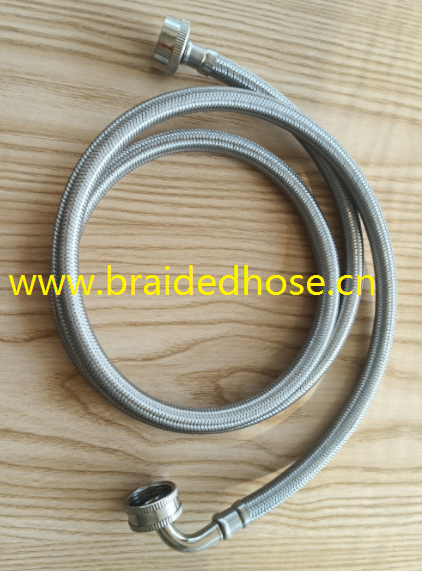Common Flexible Hose Materials
Common Flexible Hose Materials
What material is a flexible hose made of ? The answer varies widely, meaning there are many options. This section will familiarize you with the most common flexible hose materials used in various applications. You’ll learn about their advantages and disadvantages to help you choose the right option for your project.
#1 PVC Hose
As the name suggests, these hoses are made of PVC (polyvinyl chloride) plastic. PVC hoses are naturally flexible and lightweight. They can be bent or twisted without losing their shape.
PVC hoses are formed exclusively through extrusion. This process produces long, continuous profiles and tubes. First, raw materials are heated, then a barrel and screw push the molten PVC into a mold, which shapes it into a hose before cooling.
Applications:
Common in agriculture, construction, and plumbing, PVC hoses are used for irrigation, liquid/gas transfer, and drainage systems. They’re also found in vacuums and air conditioning systems.
Advantages:
1. Lightweight and easy to handle.
2. Durable—resistant to abrasion, certain chemicals, and moisture.
3. Flexible for routing around obstacles.
4. More affordable than synthetic rubber or metal.
Disadvantages:
1. Becomes brittle in extreme temperatures.
2. Unsuitable for high-pressure applications.
3. Degrades under prolonged UV exposure.
#2 NBR (Nitrile Rubber) Hose
Nitrile rubber (NBR) is a synthetic rubber derived from acrylonitrile and butadiene polymerization. NBR hoses are shaped via extrusion.
Applications:
Ideal for automotive, industrial, and hydraulic systems due to excellent oil resistance. Commonly used for fuel, oil, and lubricant transfer.
Advantages:
1. Superior oil and fuel resistance.
2. Highly durable in oily environments.
3. Withstands a broad range of temperatures and pressures.
Disadvantages:
1. Poor UV/ozone resistance.
2. Lower temperature tolerance compared to other rubbers.
3. Unsuitable for water/humid environments.

#3 EPDM Rubber Hose
EPDM (ethylene propylene diene monomer) is a popular synthetic rubber known for heat, weather, and aging resistance.
Applications:
Widely used in automotive, HVAC, plumbing, and agriculture (e.g., pumps, cooling systems).
Advantages:
1. Excellent ozone/UV/extreme temperature resistance.
2. Highly adaptable for tight spaces.
3. Resistant to water, weak acids, and alkalis.
4. More affordable than other synthetic rubbers.
Disadvantages:
1. Poor oil/fuel resistance.
2. Not suited for high-pressure use.
#4 UHMWPE (Ultra-High Molecular Weight Polyethylene) Hose
Known for exceptional abrasion and impact resistance.
Applications:
Food processing, pharmaceuticals, mining (abrasive/chemical fluid transfer).
Advantages:
1. Outstanding wear/chemical resistance.
2. Smooth surface minimizes friction.
Disadvantages:
1. Expensive and difficult to manufacture.
2. Brittle in extreme temperatures.
3. Degrades under UV/ozone exposure.
#5 TPE (Thermoplastic Elastomer) Hose
Combines rubber and plastic properties.
Applications:
Automotive, HVAC, medical devices, food processing.
Advantages:
1. Recyclable and eco-friendly.
2. UV/abrasion/chemical resistant.
3. Lighter than rubber hoses.
Disadvantages:
1. Poor extreme-temperature performance.
2. Higher cost.
3. May deform under prolonged compression.
#6 PTFE (Polytetrafluoroethylene) Hose
High-performance plastic, often reinforced with stainless steel braiding.
Applications:
Chemical processing, pharmaceuticals, food/beverage, automotive.
Advantages:
1. Chemically inert.
2. Withstands up to 260°C (500°F).
3. Flexible yet strong.
Disadvantages:
1. Expensive.
2. Prone to kinking.
#7 Nylon Hose
Lightweight and strong, sometimes reinforced with fabric/metal.
Applications:
Hydraulic/pneumatic systems (liquid/gas/powder transfer).
Advantages:
1. Abrasion/chemical/oil resistant.
2. Lightweight.
Disadvantages:
1. Brittle in cold; softens in heat.
2. Limited high-pressure tolerance.
3. UV degradation.
#8 Silicone Hose
Best for extreme temperatures.
Applications:
Food/medical/HVAC (cooling, air ducts).
Advantages:
1. Heat/cold resistant.
2. Non-toxic.
3. Chemical resistant.
Disadvantages:
1. Expensive.
2. May deform under compression.
3. Not for high-pressure use.
#9 PU (Polyurethane) Hose
Balances durability and flexibility.
Applications:
Automotive, manufacturing (vacuum/pneumatic systems).
Advantages:
1. Abrasion/oil resistant.
2. Lightweight.
Disadvantages:
1. Costly.
2. UV degradation.
3. Limited high-pressure capacity.
#10 Composite Hose
Multilayered (e.g., stainless steel, polyester, PTFE).
Applications:
Oil/gas/chemical transfer (refineries, aerospace).
Advantages:
1. Corrosion/abrasion resistant.
2. Versatile for fluids/gases.
Disadvantages:
1. Expensive.
2. Weaker than metal under extreme pressure.
#11 Stainless Steel Hose
Highly durable with corrugated/braided designs.
Applications:
High-pressure steam/fuel lines (chemical, oil/gas industries).
Advantages:
1. Heat/corrosion resistant.
2. Flexible despite metal construction.
Disadvantages:
1. Costly (especially food-grade SS304/SS316).
#12 NR (Natural Rubber) Hose
Eco-friendly but less durable.
Applications:
Agriculture/automotive (irrigation, hydraulics).
Advantages:
1. Biodegradable.
2. Affordable.
Disadvantages:
1. Poor UV/ozone resistance.
#13 Specialty Materials
· Aluminum: Lightweight (HVAC/medical).
· Fabric: Reinforced fibers (textile/vacuum systems).
· Fiberglass: Extreme heat resistance (up to 1000°F).
· Insulated: Temperature control (HVAC).
· SBR (Styrene-Butadiene Rubber): Industrial air/water transfer.
· Teflon®: Chemical/food/pharmaceutical industries.

 简体中文
简体中文 English
English